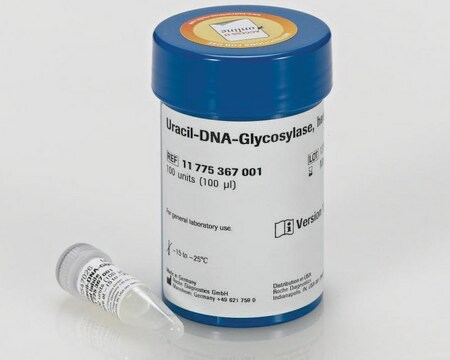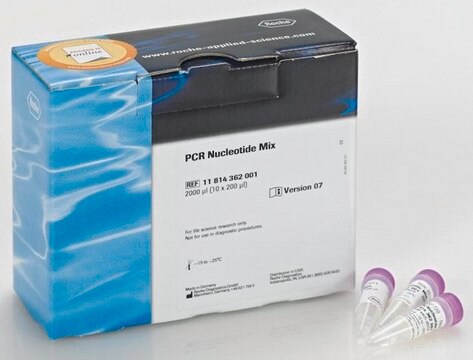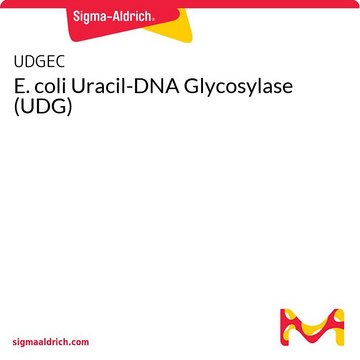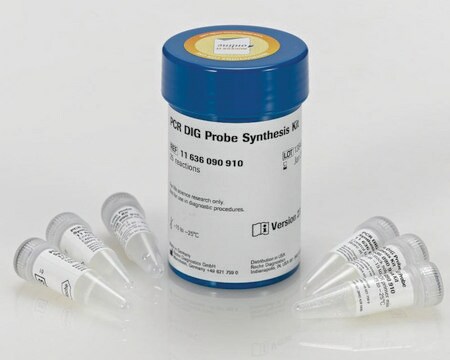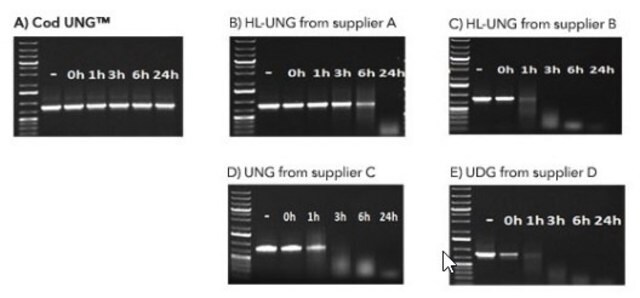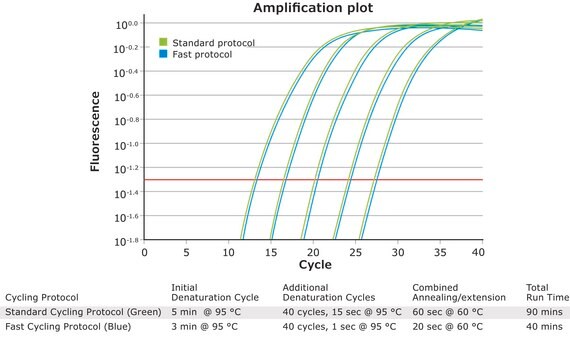11444646001
Roche
Uracil-DNA Glycosylase
recombinant from E. coli K 12
Sinonimo/i:
PCR, UDG
About This Item
Prodotti consigliati
Ricombinante
expressed in E. coli
Livello qualitativo
Forma fisica
solution
Confezionamento
pkg of 100 U
Produttore/marchio commerciale
Roche
Concentrazione
1000 U/mL
tecniche
PCR: suitable
mutagenesis: suitable
Colore
colorless
pH
7.9-8.1 (68 °F)
Solubilità
water: miscible
Compatibilità
suitable for molecular biology
applicazioni
life science and biopharma
Attività estranea
RNases 10 units, none detected
endonuclease 20 units, none detected
Temperatura di conservazione
−20°C
Categorie correlate
Descrizione generale
Specificità
- Uracil-DNA glycosylase hydrolyzes uracil-glycosidic bonds at U-DNA sites in single- and doublestranded DNA, excising uracil and creating alkali sensitive abasic sites in the DNA.
- The enzyme is more active on single-stranded DNA than on double-standed DNA.
- Activity was also observed on small U-DNA oligonucleotides and on dUMP (Duncan, unpublished observations).
- Uracil-DNA glycosylase is inactive on RNA and native, uracil-free DNA.
Heat inactivation: 95 °C for 10 min
Uracil-DNA glycosylase remains partially active (<10%) after an incubation period of 30 minutes at 95 °C.
Applicazioni
- Prevent carryover contamination in PCR
- Increase the efficiency of site-directed mutagenesis procedures
- Label oligonucleotide probes
Qualità
Definizione di unità
One Lindahl unit is defined as the amount of enzyme necessary to release of 1 μmol uracil at +37 °C in 1 minute. One Lindahl unit is comparable to 520,000 U based on our unit definition.
Volume Activity: 1 U/μl
Stato fisico
Stoccaggio e stabilità
Altre note
Codice della classe di stoccaggio
12 - Non Combustible Liquids
Classe di pericolosità dell'acqua (WGK)
WGK 1
Punto d’infiammabilità (°F)
No data available
Punto d’infiammabilità (°C)
No data available
Certificati d'analisi (COA)
Cerca il Certificati d'analisi (COA) digitando il numero di lotto/batch corrispondente. I numeri di lotto o di batch sono stampati sull'etichetta dei prodotti dopo la parola ‘Lotto’ o ‘Batch’.
Possiedi già questo prodotto?
I documenti relativi ai prodotti acquistati recentemente sono disponibili nell’Archivio dei documenti.
Articoli
DNA damage and repair mechanism is vital for maintaining DNA integrity. Damage to cellular DNA is involved in mutagenesis, the development of cancer among others.
Il team dei nostri ricercatori vanta grande esperienza in tutte le aree della ricerca quali Life Science, scienza dei materiali, sintesi chimica, cromatografia, discipline analitiche, ecc..
Contatta l'Assistenza Tecnica.